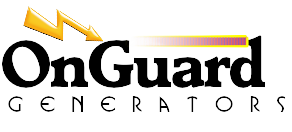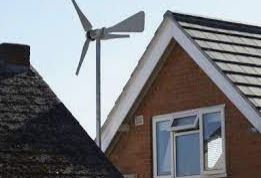If you are seek an insurance policy from the greater frequency of grid outages or just want to lower your electricity costs, a wind turbine may be a viable solution. You can put a wind turbine on your house provided that you satisfy local zoning ordinances and that there is sufficient wind coming to your property. If you are motivated by saving money on your utility bill, you will also want to get a good payback on your wind turbine investment. Roof-mounted wind turbines are typically not large enough to provide power to your entire home but with the proper wind conditions, they can be a source of power to a few key appliances. If you are looking to provide electricity to your entire home, your options include a larger tower-mounted turbine system on your property, a permanent standby generator or a solar system.
Wind turbines come in all sizes, ranging from small turbines that can be mounted on the roof of a home to the large industrial scale units that have become prevalent in many open rural areas and hilltops. For a homeowner considering a wind turbine system, a rural location makes more sense as there will be fewer zoning restrictions, more space where you can locate the system and a greater likelihood of wind adequate enough to power the system. (An urban location is usually difficult given zoning issues and the fact that a concentration of buildings nearby will impede the flow of wind). In addition, the “whooshing” noise from some wind turbines can create problems with neighbors close by.
As mentioned previously, smaller roof-mounted turbines are designed to produce enough electricity for only a handful of appliances, not the entire home. Those wanting to power their entire home need to turn to larger wind turbine systems that are mounted on large towers supported by guyed wires. To give you a sense of scale, a turbine that is capable of powering an average home will measure up to 18 feet in diameter, clearly too large to be mounted on a rooftop and more appropriate for a nearby field or large yard. And consider this: a rule-of-thumb is that to receive adequate wind power, a tower-based turbine must be 30 feet higher than any object within a 300-foot radius (such as buildings and trees). Clearly, tower-based turbines require a larger property (think one acre or more) with “clear” areas not impeded with buildings or trees. While larger tower-based systems clearly have more capacity than roof-mounted systems, zoning approval and locating them in a neighbor-friendly way can often be a challenge due to their large footprint.
One of the most important considerations is having enough wind power to justify installing a wind turbine system. One rule of thumb is that you need wind speed of at least 10 miles per hour to generate sufficient power from a wind turbine. There are maps available that illustrate the intensity of the wind in all parts of the country. Nearby airports and the U.S. Department of Energy have information on local wind patterns that may be helpful. Remember that operating a wind turbine only makes sense in an area where the average wind speed over the course of a year is sufficient (shorter bursts of extreme wind will not help you). In the U.S., the best locations for wind are the great plains, parts of the midwest, and areas close to the oceans and the great lakes. The reality is that a steady, strong wind cannot be depended upon in many locations, so for most homeowners, a wind turbine system should be viewed as a supplemental source of electricity, not as a sole source of electricity. And if you are looking for alternative sources of power away from the grid, you always have the option of a generator or a solar panel system.
What Can a Small Wind Turbine Power?
“Smaller” wind turbine systems can range from a rooftop units to smaller tower-mounted systems placed on your property. A typical rooftop unit will only be able to generate power for a few smaller appliances such as lights, a toaster oven, a miniature refrigerator or a radio. Some owners of small wind turbine systems have their systems connected to the grid, where the grid-connected turbine can lower the amount of electricity used from the utility. With this connection, if the wind turbine produces more energy than is being consumed, it is sold back to the utility for credit.
To generate enough electricity for more than a handful of smaller appliances, you must turn to tower-mounted systems, which come in a wide range of sizes. Remember that the ability of a wind turbine to produce electricity will not only depend on wind flow, but also the diameter and height of the rotor. So, if you are looking to generate power for your entire home (or a good portion of it), you will require a large system that has large rotors placed high above the ground.
How Much Power Does a Small Wind Turbine Generate?
The size of a wind turbine system is measured in watts. The smallest turbines (20-500 Watts) are sometimes referred to as “micro” turbines and are typically used to charge batteries for boats, RV’s and small vehicles. Turbines used to deliver electricity to home appliances typically fall in a range of 500 Watts to 100,000 Watts. As a very rough guide, an average home would require a turbine rated at 5,000-25,000 Watts or more to handle most, if not all, of its power requirements.
Many factors come into play–the average wind speed at your site, the site where you locate your equipment, the size and height of equipment, etc. Early on in your decision making process, take an inventory of what appliances you will be delivering power to and come up with a total wattage requirement. The watts used by individual appliances are often marked on the appliance itself or the information should be available in the owner’s manual. Note also that many appliances have “starting” watts (watts required to start an appliance) and “running” watts (watts required to run the appliance). Your total wattage requirement should include both types. And lastly, it is always a good idea to build in a cushion so that you are never left short of power. Taking an inventory of your wattage requirement up front is very important as this will help you decide wether or not a wind turbine is practical. If it is, you can then determine what size turbine system is required.
Are Small Wind Turbines Cost Effective?
The payback on your investment in a small wind turbine will be determined by several variables including: the average annual wind speed at your site, the proper placement of your equipment, the installed cost of your system and annual maintenance costs. Note that while there wind turbines in operation in all 50 states, there are not many areas in our country that have wind conditions ideal for wind turbines. Your decision on whether or not to invest in a wind turbine system should start with the average annual wind conditions at your property. And if you are looking to protect yourself from grid outages or just save money, it is a good idea to weigh an investment in a wind turbine vs. options such as a portable generator, a permanent standby generator or solar panels.
What Size Wind Turbine is Needed to Power a House?
A smaller roof-mounted turbine system will not have the capacity to deliver power to most homes, whereas a larger wind turbine system mounted on a tower can deliver the power needed, subject to the average wind speed at the site. For the average home, a tower-based system rated for between 5,000 Watts and 25,000 Watts should be sufficient. However, some caveats are in order are you determine a wine turbine’s ability to power a house. First, be sure comply with local zoning ordinances. Second, the average wind speed at the site of the wind turbine must be sufficient (think an average of 10 mph). Third, the turbine must be placed in a suitable location to capture maximum wind flow—an industry rule of thumb is 30 feet higher than any object (trees, buildings) within a 300 foot radius. Fourth, the taller the tower and the bigger the rotor blades, the more power you will generate. Lastly, your equipment should be rated for a wattage total that comfortably exceeds the wattage required of your home appliances (be sure to measure both “starting” wattage and “running” wattage).
Another thing to consider is whether or not your wind turbine system is connected to the grid. By having a grid-connected system, you can obtain power from the grid when the wind is not sufficient. In cases where the wind is giving you more power than you are using, you can “sell” the excess back to your local utility. The grid connection is a way of hedging your bets and still allows you to reduce your utility bills.

